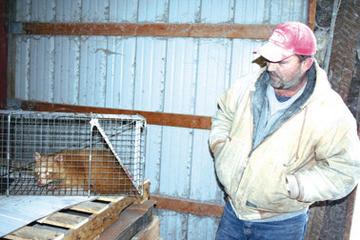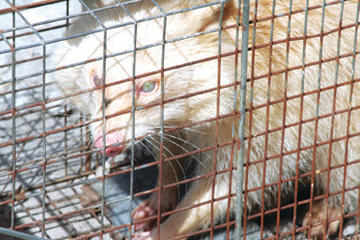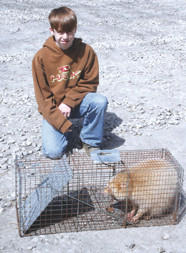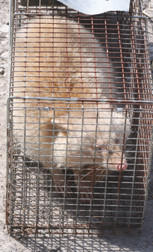Orange Raccoons, Dover Demons & Green Eyes
Posted by: Loren Coleman on April 2nd, 2008
It’s been called an “orange,” a “blond,” and a “red” raccoon. Certainly, it is a rare color phase of a common raccoon that was trapped in Greene County, Indiana, late in February and then again in March 2008. It is slowly getting more and more attention.
It’s been featured in the local media in Indiana, and I heard a short story about it on Field and Stream radio last weekend. I think people are catching and releasing the same little tan-color-phase raccoon or its relatives.
It got me to wondering, how would have people described this if it hadn’t been caught?
With it’s orange or green eyes and orange-tinted fur, could this be an unexplored answer to the mystery of the Dover Demon? Could the Dover Demon have been an orange raccoon…yes…with mange?

In April 1977, Bill Bartlett said the Dover Demon’s eyes were orange. When seen a few hours later, Abby Brabham said the Dover Demon’s eyes were green.

Orange raccoon with orange eyes: In February 2008, Kevin Blackford of rural Bloomfield watches over the orange raccoon with orange eyes that had been eating his cat’s food off his front porch. The raccoon was trapped by Craig Reel of Worthington who made arrangements to set the unusual raccoon free in the woods far from Blackford’s porch.

Blond raccoon with green eyes: In March 2008, new photos of the [same!? or similar?] raccoon show it has green eyes. The animal is golden blond in color and doesn’t have any of the normal raccoon markings on its body. The raccoon also has neon green colored eyes.

Eric Nagy, a Linton-Stockton Junior High seventh grader, poses with the caged unique raccoon he trapped west of Linton, Greene County, Indiana, in March 2008.
Seeing is believing in case of orange raccoon
Friday, February 22, 2008
By Anna Rochelle, Staff WriterNobody believed Kevin Blackford when he said an orange raccoon had been eating his cat’s food.
Blackford lives northeast of Bloomfield on Cold Springs Road in an area where unwanted cats are frequently dumped.
“My wife and I took in one of the stray cats that was dropped off, so we leave cat food out on our front porch. Then something else kept eating all of the cat food,” said Blackford.
On the lookout for the cat food thief, Blackford finally spotted the culprit.
“At first glance, I thought it was a big red tomcat, but when I stepped out on the porch, it turned around — it was no tomcat. It was an orange raccoon!” said Blackford.
When Blackford told Craig Reel and the guys over at Reel & Sons Feed Store in Worthington, they all shook their heads at his tall tale. But Blackford insisted he had seen an orange raccoon. He even said it had orange eyes.“Nobody believed me,” said Blackford.
Reel, who has a frequent problem with raccoons trying to get into his building to eat grain, decided to set one of his traps on Blackford’s porch.
“We got him right away, with just a little dab of strawberry preserves. Raccoons love strawberry preserves,” said Reel.
The next morning, the orange raccoon, in the trapping cage, was taken to Reel & Sons Feed Store where all of the disbelievers could see the unusual animal.
“I’ve never seen anything like it. It’s completely orange and it does have orange eyes. When they catch the light just right, his eyes look gold,” said Reel.
Over the course of the day, several visitors agreed they had never seen such a thing. Reel even called someone he thought knew a lot about raccoons — Jack Benham. He told Reel in all his years, he hadn’t heard of an orange raccoon.
For one day, the orange raccoon was a star and didn’t seem to be bothered by all the attention. Blackford said he seemed calm most of the day and though he hissed a few times, he didn’t growl.
At the end of the day, Reel and Blackford planned to send the orange raccoon safely back into native habitat. A man who lived in the country, far away from the Blackford’s front porch, was going to pick him up and let him go in a suitable spot deep in the woods.
Reel and several others now admit that Blackford was telling the truth. So will they believe his stories in the future?
“No, not unless he brings in proof. We’ve got to have the proof,” said Reel.

Trapper gets unusual catch: Junior high student catches golden blond raccoon
Wednesday, March 26, 2008
By Nick Schneider, Assistant EditorYoung trapper Eric Nagy was amazed when he checked a live trap Easter Sunday morning on his papaw’s farm, located west of Linton about two miles from Greene-Sullivan State Forest.
Inside the trap, the 14-year-old Linton-Stockton Junior High School seventh-grade student saw something that he wasn’t quite sure what it was.
In fact, he nor his papaw Greg Lacy had ever seen such a critter.
It is about the size of a raccoon, but isn’t the right color. This animal has a coat that is golden blond in coloration. It has the same body shape and paw configuration as a raccoon.
The hissing and very agitated animal doesn’t have any visible rings on its tail and there is no dark “bandit’s mask,” which has enhanced the raccoon’s reputation for mischief, vandalism, and thievery.
Perhaps its most unusual feature is its eye coloration of bright neon green — when the sun strikes them in the right alignment. Other times they are purplish red.
Ironically, the live trap was baited with orange-colored peanut butter crackers.
“He (Eric) didn’t know what it was. He was tickled to death,” Eric’s papaw recalled. “I hadn’t seen anything like it in my life.”
When Lacy first looked at the animal, he thought it was an opossum.
Lacy said he’s showed the catch to several experienced trappers, and none of them had seen anything like it.
He also talked to officials with the Indiana Department of Conservation and the U.S. Fish and Wildlife Service trying to find out if the animal is a raccoon and how rare it really is.
DNR Conservation Officer Mike Gregg talked with Lacy about the animal, but believes it might be a variation of an albino raccoon.
“It’s just a color phase. Sometimes there are albinism there could be a color one that just got off color,” Gregg said. “It’s probably actually an albino and the color of it might just be because they are coming out from denning. It might just be from being in the den (over the winter months).”
The adult raccoon has none of the usual “coon” markings like a mask and ringed tail.
Gregg noted that even an albino raccoon is rare.
“Usually they don’t survive long because with their color they get picked off by things,” he added.
Lacy was told by a Fish and Wildlife official that it is very rare to find a raccoon of this color — maybe 1 in 100,000 raccoons.
The unusual raccoon will probably meet a fateful demise very soon unless someone is found who would be interested in placing it in a zoo-like facility, Lacy said Wednesday.
“I’ll probably have it for another day or two and then I’m going to have to get rid of it,” Lacy added.
The Greene County man has contacted an official with the Indianapolis Zoo thinking it might be nice to donate it there so “kids could see it.”
But after he explained what kind of animal he had trapped, he was told they probably wouldn’t be interested.
“They said they were full up and didn’t have room,” Lacy said with a perplexed laugh. “I told the lady this is a rare coon. It’s not a black and white with gray coon.”
The doubting zoo woman said, “I’ve never heard of such a thing.”
He replied to her, “I’ve got one.”
Lacy, who lives near the intersection of County Road 150N and County Road 1375W, said he’s been trapping the coons on his farm since last year. The pesky animals were regularly munching on his ground swine feed, which is pretty expensive in these days of $5-plus per bushel corn.
A 100-pound bag of feed costs Lacy $10 or $11 dollars.
“Them things (the raccoons) are aggravating you know,” Lacy said. “They have been just moving in on me.
“Last year they (the raccoons) started moving in on our hog feed. They’d be in the hog feeders. You go out there at night and there would be feed strung out of the feeders. I went out there one night and there are 12 holes in a hog feeder and there was a coon in every feeder hole. They were in there eating that feed. They can eat a lot of feed and feed is expensive right now with $5.50 per bushel corn.”
Looking into the wire cage that contained the unusual catch, Lacy said with a big laugh, “It is pretty for a coon. I’ll have to say that.”
About Loren Coleman
Loren Coleman is one of the world’s leading cryptozoologists, some say “the” leading living cryptozoologist. Certainly, he is acknowledged as the current living American researcher and writer who has most popularized cryptozoology in the late 20th and early 21st centuries.
Starting his fieldwork and investigations in 1960, after traveling and trekking extensively in pursuit of cryptozoological mysteries, Coleman began writing to share his experiences in 1969. An honorary member of Ivan T. Sanderson’s Society for the Investigation of the Unexplained in the 1970s, Coleman has been bestowed with similar honorary memberships of the North Idaho College Cryptozoology Club in 1983, and in subsequent years, that of the British Columbia Scientific Cryptozoology Club, CryptoSafari International, and other international organizations. He was also a Life Member and Benefactor of the International Society of Cryptozoology (now-defunct).
Loren Coleman’s daily blog, as a member of the Cryptomundo Team, served as an ongoing avenue of communication for the ever-growing body of cryptozoo news from 2005 through 2013. He returned as an infrequent contributor beginning Halloween week of 2015.
Coleman is the founder in 2003, and current director of the International Cryptozoology Museum in Portland, Maine.










I used to have a client who had a true albino pet raccoon. It was snow white with pink eyes. Completely albino coons are very rare, but the types of raccoons with unusual coloration shown here are not too uncommon. They’re incompletely albino. They’re similar to the “golden tabby” tigers, where recessive modifier genes cause the normally black areas in the fur are replaced by reddish or brownish coloration, and/or also cause the extent of the black areas to be reduced. In some areas these albino-series raccoons are fairly common in the wild, and they also occur routinely on fur farms.
One of my friends, who had a pet store, used to buy “blond” raccoons from a breeder somewhere in the midwest. There is a wide range of colors available, from pale “blond” (which is usually called “albino” in the pet trade) to a chestnut color.
I’ve rescued several raccoons, in cases where one has been injured, for instance, or where young ones have been found and brought in by hunters. I’ve kept a few of those rescued raccoons as pets over the years. They are engaging little rascals, especially when they are young. I don’t recommend them for most people, because they can be aggressive as they mature. But for someone who is willing to make a liletime committment to the animal and respect it for what it is, having a pet raccoon can be a rewarding experience.
Allowing for a moment of levity…. So, if the “masked” black and gray/white/whatever raccoons are portrayed as “burglars,” are we now looking at a before-and-after scenario? Are these apprehended “burglars” now wearing their orange “jumpsuits.” I jest but, seriously, I have never seen such an animal and its rarity is plausible in explaining the Dover Demon sighting. Nice, correlation, Loren.
LOL.
Speaking of raccoons in jail …
Several years ago, we had a raccoon brought in to the clinic to be boarded overnight and neutered. The cages are standard stainless steel cages with solid sides and a steel grate door, with gravity latches. On the night before his scheduled surgery, that coon opened his cage and got out. But he didn’t stop there. That little rascal was too clever by half. He unlocked all of the cages in the room, and every cage in the room held a dog. Most of the dogs got out of their cages, and they basically trashed the dog room trying to “tree” the coon. The poor coon got behind a three-tier wall of cages to hide, and when we came in to work the next day, the kennel attendants had to dismantle the entire bank of cages to rescue the coon. We were lucky that the little cuss didn’t figure out how to unlatch the window or he might have made a clean getaway.
Of course, he got neutered anyway 🙂
Bloomfield Indiana is my home town more or less. 98% of my family live in Green county Indiana around 15 miles or so outside Bloomfield.
I seen about this coon about a week ago I would say on a local news link.
well i would have to say that a raccoon of this unusual color with or without mange in the right light would look like the dover demon and since the simplest answer is usually the right one looks like that is the dover demon
I live in Central Ohio. About 6-7 years ago, in a barn where I had my Horse stabled, we found a female coon and 2 kits. The female let us look at her and the babies without aggression. When I looked into her eyes I was amazed to see the most beautiful fluorescent lime green eyes! She was just the average raccoon color, but those eyes were amazing! Opossums and coons do not go with horses, so of course, she had to go. Mother animals always have backup dens, so we just disturbed her enough to get her to move out of the barn. To this day I wish I had found a way to keep her and the babies, but they belong in the wild. I have wondered ever since if this is very common, so was glad to find this site—finally. I have searched before and never came across it. Thank you for being here today!